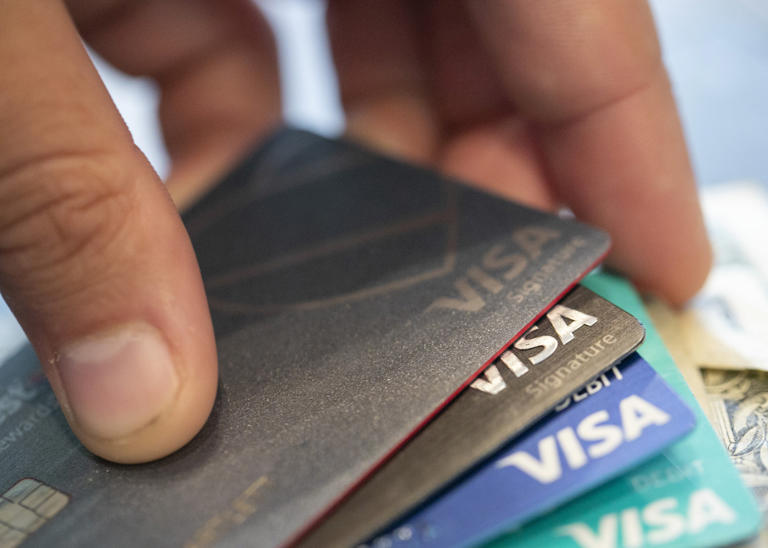Consumers are finding it increasingly difficult to manage their credit card bills, raising concerns about the potential ripple effects on consumer spending and the broader economy. According to the Federal Reserve Bank of New York’s report on first-quarter household debt, the proportion of credit card debt that is more than 90 days overdue surged to 10.7% during the first quarter of this year, the highest level seen in 14 years. This is a significant jump from the 8.2% recorded a year ago and marks the largest increase in severe delinquencies since 2011.
The total amount of credit card debt has also risen dramatically, climbing to $1.12 trillion from just under $1 trillion in the previous year. This increase is particularly troubling for younger consumers, especially those in their 20s and 30s, who are struggling the most to pay off their credit card bills. These age groups typically have lower earning power and savings, making them more susceptible to financial stress.
The Federal Reserve’s efforts to combat inflation have contributed to this situation. In response to the highest inflation rates in four decades, which peaked at 9.1% in June 2022, the Federal Reserve has implemented a series of aggressive interest rate hikes. These hikes have pushed borrowing costs to their highest levels in 23 years, affecting not only mortgages and auto loans but also credit card interest rates. While these measures have helped to cool inflation, they have also increased the financial burden on consumers, particularly those already struggling with debt.
The importance of consumer spending to economic growth cannot be overstated. When consumers struggle to pay their credit card bills, it signals potential trouble ahead. The direction of the labor market will be a critical factor in determining whether debt stress escalates. Job and wage growth have so far helped to offset some of the financial strain caused by rising prices. However, if the labor market were to weaken, this could exacerbate household financial instability. Gregory Daco, chief economist at EY, emphasized that while current economic indicators do not necessarily predict a recession, a downturn in employment could lead to increased delinquencies and a potential pullback in consumer spending.
Despite these warning signs, Wall Street has largely shrugged off concerns about rising credit debt and payment struggles. Analysts are forecasting a significant acceleration in earnings growth, from 5.6% in the first quarter to 17.1% by the fourth quarter. However, there are emerging signs of consumer fatigue and anxiety. For example, retail spending unexpectedly stalled in April, indicating that consumers may be becoming more cautious. Walmart, the nation’s largest retailer, has reported that its customers are prioritizing spending on necessities over discretionary items like home furnishings and electronics. Similarly, Starbucks has lowered its sales expectations for the year due to a decrease in customer visits, and McDonald’s has introduced more deals to attract customers who are cutting back on dining out.
The Federal Reserve now faces a complex challenge. Inflation remains stubbornly high at around 3%, above the Fed’s target of 2%. The combination of high inflation, expensive borrowing rates, and a slowing economy raises doubts about the central bank’s ability to control inflation without triggering a recession.
Credit card debt, while significant, makes up only about 6.5% of total consumer debt, according to a report by Bank of America Global Research. This mitigates some concerns, but the rise in delinquencies appears to be outpacing income growth. Many consumers may be paying only the minimum balances on their credit cards, keeping them out of delinquency but leaving them financially strained. If the economy worsens, these consumers could easily fall into severe delinquency.
Michael Gapen, a Bank of America Global Research analyst, noted that if the labor market moderates as expected, consumer spending could remain resilient. However, the elevated levels of credit card delinquencies among lower-income consumers increase their sensitivity to any negative changes in the labor market. A downturn in employment could lead to a significant rise in delinquencies and a subsequent decrease in consumer spending, which would have broader implications for the economy.
In conclusion, while the current economic indicators do not necessarily signal an imminent recession, the combination of high inflation, increased borrowing costs, and rising credit card delinquencies poses significant risks. The state of the labor market will be crucial in determining the future trajectory of consumer spending and overall economic stability. Companies and policymakers alike will need to closely monitor these developments and be prepared to respond to any signs of financial distress among consumers.
